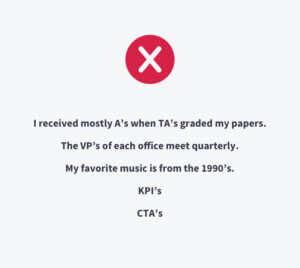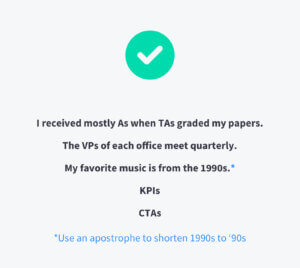Establish and Maintain Your Thought Leadership with High-Quality Content
Quality is King When it Comes to Content
Q: Do you want to know the number 1 way to get me to stop reading a piece of content?
A: Include typos and/or grammatical mistakes in it.
I know that not everyone is like me and stops reading something after coming upon a mistake; most people simply pass over the error and keep reading. But in today’s content-focused world where 87% of B2B companies use content marketing and 60% of marketers create at least one piece of content each day, high-quality pieces will get you further than poor quality content.
Content marketing includes email, social media, blog posts, live/in-person events, virtual events, and webinars. If it’s not already part of your business strategy, it needs to be as 60% of customers who read content about a product consider asking more about it or buying it. That’s a large percentage of potential customers who you don’t want to miss! Capture them with engaging, knowledgable, and error-free information.
Why Quality Matters
Quality should be the focus of your B2B writing for reasons other than just getting people to continue reading. It impacts your company’s search results, brand affinity, consumer trust, and ROI:




Mistakes get remembered more. You don’t want to be known as the company that made a mistake, especially if it’s a costly mistake, like when clothing retailer Old Navy forgot to put an apostrophe in “Let’s”, forcing them to pull their line of NFL and collegiate football shirts from shelves nationwide.
While there is more to quality than not including misspellings and grammatical errors, they are quick fixes that can be easily avoided. So, let’s take a look at some common mistakes and how we can avoid them.
Easy Things to Increase Your Content’s Quality
Don’t Be Passive, Take Action!
Which of these sentences is more impactful?
The ball was thrown by the girl.
The girl threw the ball.
I think we can all agree that the second sentence is stronger. Why? Because it’s written in active voice. In active voice, the subject of the sentence performs or takes action with the sentence taking the construction of “subject, verb, object.” Active voice has a strong, direct, and clear tone and needs fewer words.
On the flip side, with passive voice writing, the subject doesn’t directly do something. Instead, the subject comes last and is the recipient of a verb’s action, often taking the construct of “object, a conjugated form of to be + verb’s past participle, preposition, subject.”
Aim to have the majority of your writing in active voice and reserve passive voice for when you don’t know the subject or when you want to emphasize the action instead of the subject.
Can Prepositions Be Used at the End of a Sentence?
Ending a sentence with a preposition is an excellent example of how grammar rules have evolved over time. It used to be that you could never end a sentence this way. However, now it’s more commonly accepted.
Examples of prepositions include but are not limited to: about, around, at, but, by, for, from, into, near, of, off, on, towards, up, and with.
As a general rule of thumb, having a preposition at the end of a sentence is okay for emails, text messages, and notes, where the tone is more casual. More formal content pieces like research papers, business proposals, and case studies should avoid this sentence structure whenever possible.
There are times when you can’t avoid ending a sentence with a preposition and sometimes it’s more awkward to try and rewrite the sentence to move the preposition. That’s understandable, but try to minimize it.
Still not sure what to do when it comes to prepositions and what’s acceptable? Let’s look at some examples:
What did you step on?
- It is awkward to say “On what did you step?”
He needs to cheer up.
- Unless you want to channel your inner Yoda and say “To cheer up, he needs.”
Here’s where we’re at.
x This should be rewritten to “Here’s where we are.”
Which magazine was your article published in?
x Technically, this is incorrect and should be rewritten to “In which magazine was your article published?” but some might argue that the rewrite is awkward.
What are you waiting for?
- It would be awkward to say “For what are you waiting?”
Watch for Modifiers
A modifier is a word, phrase, or clause that describes another word. For example, “She bought a white historical farmhouse.” While the modifiers white and historical aren’t needed, they add description and define the farmhouse. Who doesn’t like details and descriptions? I know I do. But, a misplaced or dangling modifier can give your sentence an unintended meaning.
When a modifier is misplaced, it appears in the wrong part of the sentence and appears to modify something other than what was intended. Let’s look at an example:
- The fisherman left his live sack of bait on the dock.
- Here, it sounds like the sack is live, and while I don’t fish, I know that the sack can’t be live, but the bait should be.
- The fisherman left his sack of live bait on the dock.
- That looks better!
Misplaced modifiers can also change the meaning of the sentence, as shown by the placement of “just” in these examples:
- Just Dave was picked to host the podcast.
- This implies that Dave is the only host.
- Dave was just picked to host the podcast.
- This implies that Dave just found out he’s hosting the podcast.
- Dave was picked to host just the podcast.
- This implies that there is something in addition to the podcast, but Dave won’t be hosting it.
Another type of modifier to be on the lookout for is a dangling modifier. With dangling modifiers, the thing that is supposed to be getting modified is missing. Sentences with dangling modifiers often start with “-ing” words, prepositions, or descriptive phrases and the subject comes after the main clause or is missing entirely. Here are some examples:
- Without knowing his name, it was difficult to introduce him.
- Who didn’t know his name? The subject is missing here. Add a subject, and the sentence becomes clearer:
- Because Lisa did not know his name, it was difficult for her to introduce him.
- Who didn’t know his name? The subject is missing here. Add a subject, and the sentence becomes clearer:
- Upon finishing work, the dogs went for a walk.
- I don’t think dogs work, so who finished work and took the dogs for a walk?
- Upon finishing work, he took the dogs for a walk.
- I don’t think dogs work, so who finished work and took the dogs for a walk?
Double-check your work to make sure the right things are being modified and not changing what you mean!
Use Apostrophes Correctly
One of my favorite things about Christmas time is receiving Christmas cards. Yet, Christmas cards are often perfect examples of my biggest pet peeve: incorrect apostrophe use.
I’m shouting this one from the rooftops: Apostrophes DO NOT make things plural!
h
Apostrophes are used to form a contradiction:
- it is = it’s, has not = hasn’t.
They are also used to show possession or ownership:
- SmartAcre’s office (SmartAcre® possesses the office)
- The cats’ food (there is more than one cat and all of them own the food)
- Oliver and Andrew’s marketing agency (Oliver and Andrew are co-owners of a marketing agency)
- Oliver’s and Andrew’s marketing agencies (Oliver and Andrew own separate marketing agencies but they are being discussed together)
Apostrophe usage gets a little tricky when it comes to words ending in S:
- Use an apostrophe for singular words or names
- James’s party
- Don’t use an apostrophe if it creates a double or triple “s”
- The employees’ desks (not the employees’s desks)
- Use just an apostrophe for plural proper nouns
- The Durkins’ vacation (not The Durkins’s vacation)
So I know I just screamed that apostrophes don’t make things plural, and that is correct 99.99% of the time. But, there is an exception to the rule: to pluralize lowercase letters. With lower case letters, apostrophes make it easier to read and are therefore acceptable:
- Dot your i’s is much easier to read than Dot your is
- Cross your t’s
- Do’s and Don’ts (you don’t need the apostrophe after the t because it’s clear enough)
The other way that apostrophes are misused are with uppercase letters used as words, for abbreviations, and when numerals are used as nouns:
If there’s one error that you focus on fixing more than the others in this blog post, let it be this one, and stop using apostrophes for pluralization. When writing emails, be sure to start with “Hi employees”, “Dear valued customers”, not “Hi employee’s” or “Dear valued customer’s”. When it doubt, ask yourself “Am I talking about/to a group of people, or am I talking about someone owning something?” If the answer is the former, don’t use the apostrophe, please.
And next Christmas if you’re not sure how to pluralize your last name (depending on how your name ends, it’s not as simple as just adding an “s” to the end), just say “The (last name) Family” or use your first names. Just let me have joy in opening your card and seeing your smiling face instead of being sad when I see an all-too-often made, yet easily fixable, mistake.
Time to Produce High-Quality Content
Passive voice, prepositions to end sentences, dangling or misplaced modifiers, and incorrect apostrophe usage are just the tip of the iceberg when it comes to grammatical errors in content. We could get into proper word choice (anyone up for a game of pick the right one: who/that/which, compliment/complement, affect/effect?), incomplete comparisons, proper comma usage (confession: in case it wasn’t obvious throughout this post, I’m an Oxford comma girl), the list goes on and on.
However, that would make this already long post even longer and I’m trying to not completely overwhelm you. So, for now, focus on getting the 4 topics above under your belt; then we’ll add to the list and give you more things to master to ensure you produce high-quality B2B content consistently. Before you know it, you’ll be ranking higher in SERP, your brand affinity and trust will increase, and leads will be pouring in. Who knew high-quality content could make such a difference?



